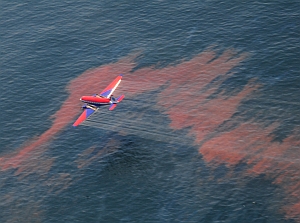A review of the worst two oil spills in U.S. history shows that oil-degrading microorganisms played a significant role in reducing their overall adverse environmental impacts. The results of the review of the 2010 BP oil spill in the Gulf of Mexico and Exxon Valdez running aground in Alaska’s Prince William Sound in 1989 are published as the cover story in the 15 August issue of the journal Environmental Science and Technology.
The authors of the paper — microbial ecologist Terry Hazen with the Lawrence Berkeley National Laboratory and Ron Atlas, a University of Louisville biology professor — note that except for the discharge of large amounts of crude oil, the circumstances of the two events had little in common.
In March 1989, the oil tanker Exxon Valdez ran aground on Bligh Reef in Prince William Sound, spilling an estimated 11 million gallons of heavy crude oil from Alaska’s North Slope, which spread as a surface slick in this sub-arctic region. The strong tidal currents and 50 mile-per-hour storm winds washed ashore much of the oil, which made clean-up of the shoreline the primary focus.
The BP Deepwater Horizon spill was the result of an explosion of the drilling rig in April 2010 that led to an uncontrolled blowout of the wellhead. The spill released an estimated 779 million liters (205.8 million gallons) of light crude oil — much more than the 41.6 million liters lost by the Exxon Valdez — and considerable amounts of methane.
With the primary goal of preventing oil from ever reaching the shoreline, a combination of strategies were employed, including controlled burns, skimming, siphoning from the wellhead, containment booms, shoreline berms, and beach sand mixing. Also, for the first time, heavy concentrations of dispersants were applied to the deepwater leaking well, primarily for safety reasons to prevent the highly flammable oil from reaching the surface immediately above the wellhead where a great many ships had congregated.
The authors say that petroleum hydrocarbons in crude oils, such as those released into marine ecosystems by the Exxon Valdez and BP spills, are derived from aquatic algae millions of years ago. Because these hydrocarbons regularly seep into the environment from underground reservoirs, especially in marine environments, a large and diverse number of microorganisms, including bacteria, archaea and fungi, have evolved to use these petroleum hydrocarbons as sources of food and energy for growth.
In both cases, the clean-up strategies involved accelerating the feeding processes by these microbes. “In the case of the Exxon Valdez spill, nitrogen fertilizers were applied to speed up the rates of oil biodegradation,” says Hazen. “In the case of the BP Deepwater Horizon spill, dispersants, such as Corexit 9500, were used to increase the available surface area and, thus, potentially increase the rates of biodegradation.”
In the case of the BP spill, the dispersed oil droplets, with a concentration of less than 10 parts per million total petroleum hydrocarbons, have been likened to a cloud or plume. “Our studies showed that microbial activity within this cloud was significantly higher than outside the cloud,” says Hazen.
Research by the Berkeley Lab and others determined that indigenous microbes, including a previously unknown species, degraded the oil plume to virtually undetectable levels within a few weeks after the damaged wellhead was sealed. Another study showed that the methane and other gaseous compounds in the water column were also almost completely degraded within three months.
The full impact of the surface oil on shorelines, however, has not yet been determined. In their paper, Hazen and Atlas say that “up to 40-percent of the oil was lost in the water column between the wellhead and the surface, largely due to dissolution and mixing as the oil moved to the surface and evaporation as soon as it reached the surface.” This lowered the hydrocarbon concentrations and changed the composition of the oil that did reach the shore. But they also say that it is too early to tell the impact of the BP oil spill on the delicate marsh environments and beach communities in Louisiana, Mississippi, Alabama, and Florida.
Read more: NIH Study to Research Health Effects of BP Oil Spill
* * *


 RSS - Posts
RSS - Posts
[…] Read more: Microbes Reduced Adverse Impact of BP, Exxon Valdez Spills […]